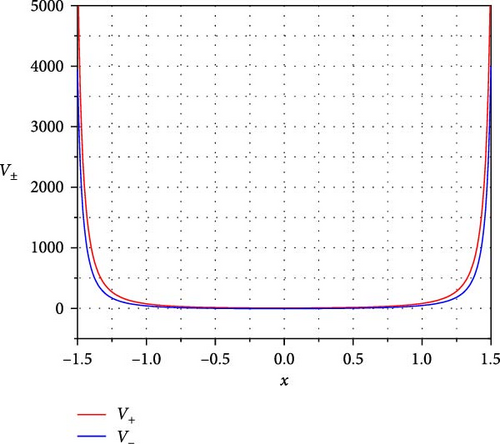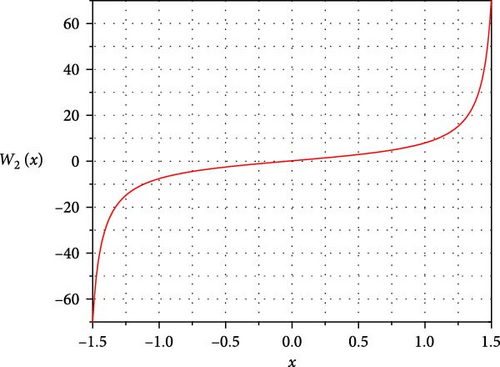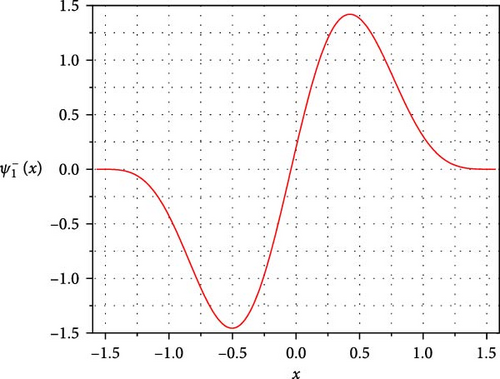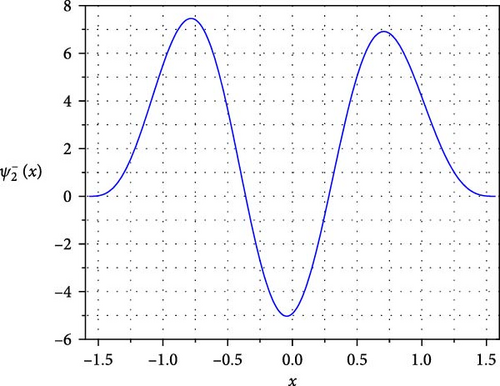A Method of Constructing Superpotentials by Combining Two Functions Based on Shape Invariance
Abstract
Supersymmetric quantum mechanics (SUSYQM) plays an important role in solving the Schrödinger equation, and it is also important to find more superpotentials that can be solved accurately. On the basis of studying the characteristics of existing superpotentials, the authors find a missing superpotential and put forward a method by combining two functions to construct all existing solvable superpotentials and prove the existence of the missing superpotential. First, based on the idea of SUSYQM, this paper studies the shape invariance of the partner potentials with the form of two functions and obtains the energy spectrum in many different cases. Second, according to the results of solving differential equations satisfied by two functions, the authors not only construct most existing solvable superpotentials successfully but also generate a missing solvable superpotential. Third, for the missing solvable superpotential, some discussions are made, such as the corresponding partner potentials, energy spectrum, ground state wave function, and excited state wave functions. Lastly, the summary is made, and the prospects are projected.
1. Introduction
In quantum mechanics, the solution of the Schrödinger equation with different potential constraints is a very core content, which is widely used in atomic physics, molecular chemistry, nuclear physics, nanostructure, and solid state physics [1–3]. The supersymmetric quantum mechanics (SUSYQM) method can accurately solve the energy and wave functions of quantum systems with certain potential, which brings new prospects for the development of quantum mechanics [4, 5].
In SUSYQM, one main research direction for supersymmetry is to utilize the Galois group theory method, focusing on the group symmetry satisfied by operators and to study from the perspective of Lie groups and Lie algebras in order to reveal more physical laws. This approach emphasizes the symmetry of the system and can also smoothly transition the research to the fields of quantum field theory, high-energy physics, and even cosmology [6, 7]. For instance, Acosta-Humanez [8] demonstrates that supersymmetry quantum mechanics problems can be analyzed and solved through differential Galois theory. Specifically, by studying the integrability of the Schrödinger equation, the author establishes a connection with the differential Galois group. These conclusions not only showcase the application of differential Galois theory in supersymmetry quantum mechanics but also provide a theoretical foundation and new research directions for future studies. In 2024, Contreras-Astorga, Escobar-Ruiz, and Linares [9] revisited the SUSY partner Hamiltonians of the quasi-exactly solvable sextic potential from a Lie algebraic perspective.
The other main research direction involves following the construction of quantum mechanical systems to solve the energy spectrum and wave functions of the Schrödinger equation under solvable potential constraints and to explore more exactly solvable potentials. In 1983, Gendenshtein proposed shape invariant potentials, which means two supersymmetric partner potentials that are similar in shape, differ by only a constant, and have the same intrinsic energy [10–12]. Then, Dutt, Khare, and Sukhatme [13] successfully constructed a dozen kinds of superpotentials whose energy spectrums and wave functions can be accurately solved by using supersymmetry and found that their partner potentials all belong to shape invariant potentials [14, 15]. In 2021, Benbourenane Jamal used shape invariance to solve a new superpotential and obtained an exact solution of the Schrödinger equation [9]. In the past 2 years, our team has also successfully proposed several new superpotentials, obtained energy spectrums and wave functions, and expanded the number of superpotentials that can be accurately solved [16–18]. At present, there are only a dozen superpotentials that can be solved by SUSYQM, including harmonic oscillator potential, Coulomb potential, and Morse potential [2, 15, 9, 17, 19, 20].
Further study of the existing superpotential shows that most of them are composed of two terms, and after derivation or squaring of these two terms, there will be a certain relationship, such as similar terms. Therefore, based on this idea, we can also propose a superpotential composed of two arbitrary functions, obtain the differential or algebraic relationship between the functions according to the shape invariance satisfied by the partner potentials, and thus determine the two functions by solving the differential equation or algebraic equation. Based on this idea, this paper first briefly reviews the basic idea of SUSYQM. Second, we describe the method of constructing solvable superpotential by combining two functions. This method not only constructs all existing solvable superpotentials but also finds a missing solvable superpotential. Third, we determine the energy spectrums in various cases according to the shape invariance. Fourth, we solve the solutions of the Schrödinger equation with the missing superpotentials, including partner potentials, ground state wave functions, and excited state wave functions. Finally, the full paper is summarized and prospected.
2. The Introduction of the SUSYQM
3. The Idea of Constructing Solvable Superpotentials
The specific expression of the existing superpotentials are shown in Table 1. Further study found that most superpotentials are composed of one or two terms, and there is always a certain correlation between terms. For example, the three-dimensional harmonic oscillator superpotential has two terms and is based on Equation (4), there will be a cross-term produced by squaring in its corresponding partner potentials. And the cross term is a constant term produced by and r. Another example is Scarf (hyperbolic) superpotential, and based on Equation (4), there are a derivative term and a cross term produced after the square in its corresponding partner potentials. The derivative of sech x is sech x tanh x, and the cross term of is also similar to sech x tanh x. These two terms can obviously be merged into similar terms.
| Superpotentials | W | |
|---|---|---|
| Harmonic oscillator | wx/2 | nw |
| 3D harmonic oscillator | wr/2 − (l + 1)/r | 2nw |
| Coulomb | ||
| Morse | A − Be−αx | A2 − (A − αn)2 |
| Eckart (I) | ||
| Scarf I (hyperbolic) | A tanh x + B sech x | A2 − (A − n)2 |
| Rosen–Morse (hyperbolic) | ||
| Scarf II (hyperbolic) | A coth x − B csch x | A2 − (A − n)2 |
| Scarf I (trigonometric) | A tan x − B secx | (A + n)2 − A2 |
| Rosen–Morse (trigonometric) | ||
| Scarf II (trigonometric) | A cotx + B cscx | (A + n)2 − A2 |
| Posch–Teller 1 (trigonometric) | A tan x − B cotx | (A + B + 2n)2 − (A + B)2 |
| Posch–Teller 2 (hyperbolic) | A tanh x − B cothx | (A − B − 2n)2 − (A − B)2 |
| Matching with Rosen–Morse I (trigonometric) | — |
Therefore, we can assume that the superpotential itself is composed of two functions, and there are some correlations between the two functions, such as differential relationship and algebraic relationship. Then, the relationship between the relevant parameters or coefficients can be determined according to the shape invariance that the corresponding partner potentials meet so as to achieve the purpose of solving the supersymmetric quantum mechanical system under the constraint of the potentials.
Furtherly, from Table 1, it can also be found that Scarf I (hyperbolic) superpotential A tanh x + B sech x is matched with Scarf II (hyperbolic) superpotential A coth x − B csch x,
Eckart (I) superpotential is matched with Rosen–Morse (hyperbolic) superpotential , Posch–Teller 2 (hyperbolic) superpotential A tanh x − B coth x is matched with Posch–Teller I (trigonometric) superpotential A tan x − B cotx, and so on. But there is no superpotential matched with Rosen–Morse (trigonometric) . The one that matches is . Although can be obtained by translating , we can still consider as a missed superpotential (similar to Scarf I [trigonometric] and Scarf II [trigonometric], which have the same translation relationship but are still different solvable superpotentials).
If the expression of f′(x) or p′(x) can be combined with f2(x), p2(x), f(x)p(x), or f(x), p(x), then by eliminating the term containing the unknown variable x in Equation (15), a system of equations can be established to determine the additive constant, and then the energy spectrum can be calculated using the iterative idea. Moreover, if the expression of f′(x) or p′(x) can be combined with f2(x), p2(x), f(x)p(x), or f(x), p(x), it means that some differential relationship can be established between f′(x) (or p′(x)) and f(x) (or p(x)) to form a differential equation or system of differential equations. By solving this differential equation or system of differential equations, we can obtain the expression of the functions f(x) and p(x), and thus determine the specific superpotential. Further, if we can also derive the missing superpotential, it will further illustrate the value of this method.
4. Determination of Energy Spectrums
To determine f(x) and p(x), and even finally determine the superpotential W(x), we must discuss according to the value of the parameters.
4.1. A = 0 and B ≠ 0
- 1.
When B1 = B0 = B and k = 0, that is, p′(x) = kf(x)p(x) + h = h, then the energy spectrum is as follows:
(22)Then we can get p(x) = hx + c and W1(x, B, C) = Bp(x) + C is the linear harmonic oscillator potential. - 2.
When B1 = −B0 and C = 0, that is, p′(x) = kf(x)p(x) + h = h. In this case, f(x) can be any function, which leads to , but the system has only one state, which will not be discussed here.
4.2. A ≠ 0 and B = 0
- 1.
When se > 0, it can be solved as follows:
(27)where c1 is an arbitrary constant (c1 and c2 appeared in the following text are arbitrary constants).- i.
When and c1 = 0 (),
(28)W2(x, A, G) in Equation (28) happens to be the missing superpotential matched with . - ii.
When and . W3(x, A, G) is Rosen–Morse (trigonometric) superpotential.
- i.
- 2.
When se < 0, the first expression of Equation (17) can be solved as follows:
(29)or(30) - 3.
When s ≠ 0 and e = 0, the first expression of Equation (17) can be solved as follows:
(31)When s = 1 and . And the Coulomb superpotential can be constructed. - 4.
When s = 0 and e ≠ 0, the first expression of Equation (17) can be solved as follows:
(32)
In particular, when e = 1 and c1 = 0, it is similar to the linear harmonic oscillator potential, but with only singlet states.
4.3. A ≠ 0 and B ≠ 0
- 1.
C ≠ 0, according to Equation (19), there are s = 0 and k = 0, and then f′(x) = e and f′(x) = e. So we can solve for f(x) = ex + c1 and p(x) = hx + c2. Take them back into Equation (12) and we can get W8(x, A, B) = (Ae + Bh)x + c, which is a linear harmonic oscillator potential with only a single state.
- 2.
C = 0, according to Equation (19), we can get the following:
The reason why the energy spectrum is such an expression is that the V±(x) contains, which is noncancellable. According to a1 = a0 + s, the energy spectrum should conclude , and according to noncancellable constant terms ±bh, the energy spectrum should conclude 2nbh.
- i.
When s = k ≠ 0 and se > 0, according to the first expression of Equation (17), we have
- b.
When h ≠ 0, substituting f1(x) and f2(x) of Equation (23) into the second expression of Equation (17) separately, we can obtain the following:
- ii.
When s = k ≠ 0 and se < 0, according to the first expression of Equation (17), we have
- a.
h = 0, substituting f1(x) and f2(x) into the second expression of Equation (17) separately, we can get
- b.
h ≠ 0, substituting f1(x) and f2(x) into the second expression of Equation (17) separately, we can obtain the following:
- iii.
When s ≠ 0 and e = 0, according to the first expression of Equation (17), we have the following:
- a.
When h = 0, according to the second expression of Equation (17), it can be solved that
- b.
When h ≠ 0, according to the second expression of Equation (17), it can be solved as follows:
- iv.
When s = 0 and e ≠ 0, according to the first expression of Equation (17), we have the following:
- a.
h = 0, according to the second expression Equation (17) it can be solved as follows:
- b.
h ≠ 0, according to the second expression of Equation (17), it can be solved
- v.
if f′(x) = 0, according to the first expression of Equation (17), we have
- a.
When h = 0, substituting f1(x) and f2(x) into the second expression of Equation (17), we have
- b.
When h ≠ 0, according to the equation satisfied by p(x) in potential, it can be solved as follows:
It shows that they are almost the same and produce no new results by comparing W23(x) with W21(x).
Through the above discussions, we determine all of the existing solvable superpotentials, and also derive the previously missed superpotential. It shows that the method of determining superpotentials by combining the two functions that we proposed is feasible and effective.
Generally speaking, the energy spectrum of the above solvable superpotential has been given, but when it comes to specific functions, the relationship between functions is sometimes more complicated than the shape invariant relationship shown by Equation (18), and the energy eigenvalues of the Schrödinger equation may also change slightly. So it is necessary to further discuss the energy eigenvalues and the eigenwave functions of the Schrödinger equation with the derived missing superpotential.
5. Determinations of the Energy Eigenvalue and the Eigen Wave Function
From the previous section, it can be seen that the method by combining two functions can indeed construct the missing superpotential (to maintain consistency with the format in Table 1, we will change “G” to “B” in the following text), which is obviously a solvable potentials since it is obtained according to the shape invariant relationships. Because the superpotential is actually a deformation of the Rosen–Morse (trigonometric) superpotential, its application should also be similar to that of the Rosen–Morse (trigonometry) superpotential (the trigonometric Rosen–Morse potential has many applications in theoretical and mathematical physics [26]). Although for the missing solvable superpotential, it can be theoretically proven that translation does not cause changes in the energy spectrum, further research on it is still necessary. First, it is necessary to further study whether its energy spectrums change. Second, since it is a solvable superpotential, it means that the partner potentials, the ground states and the excited states need to be further determined. Third, Compean and Kirchbach [27] derived the trigonometric Rosen–Morse potential based on the form of the Eckart potential (here it is represented by Eckart I potential) and solved the Schrödinger equation using the Sturm Liouville technique. The energy spectrum and the eigenwave functions were obtained, and the triconometric Rosen–Morse superpotential was derived based on using the ground state wave function ψ0(x). Due to the lack of shape invariance and the fact that the energy spectrum is not derived based on SUSYQM, the results are different from our current findings. Therefore, it is also necessary for us to study the solution of the Schrödinger equation under the constraint of the corresponding potential in this study. We will discuss those problems in the next.

Setting A = 5 and B = 1, we can plot the curves of the superpotential and the ground state wave function as shown in Figure 2.


Setting A = 5 and B = 1, we have plotted the first and the second excited state wave functions in Figure 3.


6. Conclusion and Prospect
Based on the existing solvable superpotentials of SUSYQM, a missing superpotential is found according to the characteristics of existing superpotentials, and a method through combining two functions to construct a superpotential is proposed. By solving the differential equations satisfied by the two functions, the concrete forms of the functions are determined. According to the solutions, we not only reproduce all of the existing solvable superpotentials by assigning values to the parameters but more importantly, we also successfully obtain the missing solvable superpotentials. After comparing with the study of Compean and Kirchbach [27], we solve the energy spectrums, the ground state, and the excited state wave functions of the Schrödinger equation with the missing superpotentials. It shows that the method by combining two functions is a good way to construct solvable superpotentials effectively.
Combined with the previous research of our research group, we found that it is possible to find more solvable superpotentials based on SUSYQM, although this paper only analyzed and discussed in terms of a specific relationship between the two functions. In fact, in Table 1, there are still several types of superpotentials that have not been constructed, because the relationships between those two functions are not only described by Equation (17) in this article but also have many other forms of relationships. This method is proposed based on the shape invariance of SUSYQM and the solution idea of the Riccati equation without considering other solvable potentials that are not suitable for supersymmetric thinking and cannot be treated with shape invariance. However, there are many other solvable potentials, and further research is needed to determine whether similar methods are also feasible. Therefore, based on the method by combining two functions, it is still worthy to further study. We also expect to be able to construct more solvable superpotentials.
Consent
We confirm that any images, tables, figures, or text included in this paper have been obtained with the appropriate copyrights or permissions and are in compliance with copyright laws.
Disclosure
This research work represents our original contributions, and all research methods, data collection, analyses, and results presentation are our own work. We have not engaged in any form of plagiarism, replication, or unauthorized use of others’ research work or findings. Our research process has been conducted with honesty and integrity. We have not fabricated, manipulated, or altered any data, results, or experiments. The data and results presented are true and accurate.
Conflicts of Interest
The authors declare no conflicts of interest.
Author Contributions
Wenxin Qiu and Yin Yin are co-first authors.
Funding
No funding was received for this manuscript.
Open Research
Data Availability Statement
All relevant data are within the paper.




